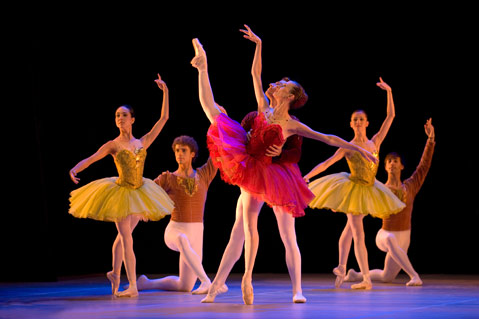Corella Ballet’s Santa Barbara Premiere
Classical Company Presents a Mixed Bill

There are superstars who build entire careers around their own talent, and then there are those who step out of the limelight to give something back to the art form. Ángel Corella is one of the latter. The Spanish-born ballet dancer has had the kind of meteoric career most artists only dream of: He was 19 years old when the American Ballet Theatre (ABT) discovered him and invited him to join the company as a soloist; he was promoted to principal dancer the following year. Now 35, Corella has spent more than a decade performing with the top companies in the world—London’s Royal Ballet, Milan’s La Scala, Russia’s Kirov, and the New York City Ballet. He’s won numerous honors, including the prestigious Prix Benois de la Danse, and had dances created for him by such notables as Mark Morris, Twyla Tharp, and Lar Lubovitch.
Yet, outstanding success as a performer hasn’t been enough for Corella. Ten years ago, he started a foundation to raise funds for his own repertory company, and in April 2008, Corella Ballet began rehearsals in Segovia, in the Castilla y León region of Spain. The only classical ballet company in the country, they’ve quickly risen to international prominence, with a touring schedule to rival any of the great ballet troupes and a reputation for top-notch dancers. The company will perform a mixed bill next Monday, November 8, at the Granada.
Ballet dancers’ careers are notoriously short, but it isn’t injury that’s convinced Corella to take on the work of running his own company; in fact, he’s still dancing. Speaking on the phone last week, the young director explained his urge to push beyond performance. “There is a moment in your career where you have done all the Swan Lakes, all the Romeo and Juliets, and you are ready for something more,” he said. “Directing a company has been very exciting because while I continue to have my own career, I now have a hand in the careers of all these other dancers.”
Corella grew up in Spain during a period when the only national dance companies, Ballet Nacional de España and Compañia Nacional de Danza, focused on flamenco and contemporary dance. Leaving Spain was the only way to pursue professional ballet training. A combination of extraordinary talent and lucky breaks made his journey relatively easy, but he acknowledges it’s not that way for most. “There are so many dancers living abroad, suffering, trying to get into companies, without any money or support,” he said. His hope is to provide another option to the next generation of Spanish ballet dancers.
As an artist working in America, Corella learned not to expect governmental support for the arts. To that end, he’s set up his company to rely on private funding, an unusual model in Europe, which has to some degree cushioned the company from the worst of the Spanish recession. Corella says he’s sad when he thinks about his country’s lack of support for classical ballet. “Everywhere in the world, you go to the opera house and you can see great opera and great ballet,” he remarked. “Spain is the only country that never had that. The only things being supported here are soccer and bullfighting.”
The silver lining to this situation is that Corella faces little competition. In three years, he has attracted some of the top soloists and principal dancers in the world to Corella Ballet Castilla y León. And many are Spaniards returning home for the first time in their careers. The company’s gaining a reputation for stunning technique and an unusually strong contingent of male dancers.
One particular piece on the Santa Barbara program, Stanton Welch’s “Clear,” showcases these men. Welch choreographed “Clear” in the immediate aftermath of 9/11; it’s set to Bach, and Corella calls it “a perfect example of the desperation and hope” that defined that era. Also on the program is the clean-cut, classical “Bruch Violin Concerto No. 1,” choreographed by the late Clark Tippet, as well as “Soleá,” a duet created by Spanish flamenco artist María Pagés and performed by Corella and his sister, Carmen.
Rounding out the program is Christopher Wheeldon’s “Danse à Grande Vitesse,” set to the driving music of Michael Nyman. “The music takes you on and on, and by the end of it, you’re at the edge of your chair waiting to jump onstage,” Corella said of this work.
Corella doesn’t consider himself a choreographer, preferring to work with the top dance-makers in the world. So far, dancing and directing is more than enough to keep him busy. “It’s one thing to get up in the morning and think only about yourself: to train yourself, rehearse, take class, and go home,” he explained. “Now I do all that plus casting, leading rehearsals, fundraising and budgeting, keeping track of which dancer is getting better and which is getting worse.” It’s not easy, he says, but it’s worth it for the moments when he stands in the wings during a performance looking on in awe at some of the world’s most talented dancers—his dancers.
4·1·1
Corella Ballet Castilla y León performs at the Granada Theatre (1214 State St.) on Monday, November 8, at 8 p.m. For tickets, call 893-3535 or visit artsandlectures.sa.ucsb.edu.



